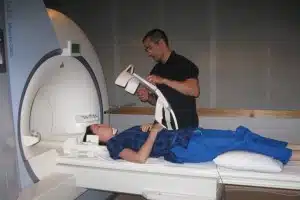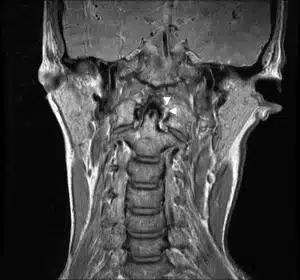
New Brisbane research suggests that fat deposits in the neck muscles are the key.
“We’ve found that people with long term injury have large amounts of fat infiltration in their neck muscles,” says Dr James Elliott, a postdoctoral research fellow with the Centre for Clinical Research Excellence in Spinal Pain, Injury and Health at the University of Queensland (and former US professional baseball player). “Something is causing that difference, and it isn’t their body weight,” he says.
The breakthrough was the development of a new technique in MRI (magnetic resonance imaging). The next step in the research will be to determine how soon after injury the changes occur.
The annual reported costs associated with whiplash are staggering at $530 million in Queensland; £9 billion in the UK and $US29 billion in the USA. This is a significant economic (and social) burden.
“Four out of ten people who have had a whiplash injury will continue to have some ongoing pain for 6 months and 20-25% of them will continue to report symptoms more than three years later,” says James.
“We don’t know the exact reasons as to why, but it’s clear that if symptoms persist for six months following injury, the status of a whiplash patient is unlikely to change in the long-term,” he says.
“If we could make an accurate and early diagnosis we could put more effort into early treatment of the more complex cases. Unfortunately, the value of the gold-standard diagnostic test (MRI) has shown to be poor if the aim is to identify injury in the neck. However most MRI based studies have been looking at specific neck tissues (e.g. vertebral discs, joints and ligaments).”

James Elliot with patient pre-MRI scan. The scan will measure the amount of visible fat within muscles of the neck (credit: James Elliot, University of Queensland)
“We took a different approach. We use MRI to measure the amount of visible fat within muscles in the neck,” says James. Why fat? “In treating patients with chronic whiplash, I kept seeing fat deposits on their MRI scans,” he says. It did not appear to be related to body weight, and other researchers had found fat deposits associated with lower back pain.
And that is what brought him to Australia to pursue his PhD studies with Gwen Jull in the whiplash diagnostic unit at The University of Queensland.
“Australia and in particular the group at UQ, have produced some of the world’s most prolific research related to whiplash, thus it was an amazing opportunity for me to join such a team” says James.
“We’ve now shown this measure is reliable and clinically friendly, James says. “It is the first of its kind in the world to provide objective markers of the chronic whiplash condition.
Now James and his colleagues are working to determine if the marker can be used for diagnosis.
If successful, the current study will help clinicians identify patients who may need more intensive support. And in the long term it will lead to a better understanding of whiplash and improved treatment.
James Elliott is one of 15 early-career scientists presenting their research to the public for the first time thanks to Fresh Science, a national program sponsored by the Australian Government.
For interviews, please contact James on 0406 786 053 or 07 3365 4529
For Fresh Science contact: Sarah Brooker on 0413 332 489 and Niall Byrne on 0417 131 977 or niall@freshscience.org. Further details and photos at www.freshscience.org.
Background information
Further findings of how the changes seen by James and his colleagues relate to clinical symptoms will be published shortly in the European Spine Journal – Elliott J, Sterling M, Noteboom J, Treleaven J, Galloway G, Jull G. The Clinical Presentation of Chronic Whiplash and the Relationship to MRI Fatty Infiltrates in the Cervical Extensor Muscles: A Preliminary Investigation.
Currently, James is working directly with Michele Sterling at the University’s Centre for National Research on Disability and Rehabilitation to investigate: 1) how soon following injury these muscular changes occur; 2) whether it occurs only in those who transition to chronic pain; and, 3) whether the presence of these muscle findings improve the classification of patients who have had a whiplash injury and thus provide for an easy and objective/prognostic measure for whiplash. They are now testing their techniques on subjects with acute whiplash in a large prospective clinical study.
From baseball to whiplash
Before shifting to a career in Physical Therapy and medical research, James was a professional baseball player (1990-1992) in the San Diego Padres Baseball organisation.
Prior to that he was drafted by the Houston Astros Baseball Club (1987) but opted to attend university at the University of Denver, Colorado on a baseball scholarship.
James was one of only two players from the University of Denver to ever earn First Team All-America baseball honours (1988). A catcher, he departed University early to pursue his dreams in the professional ranks as a player with the Padres and also worked in front-office with The Colorado Rockies Baseball Club (1993-1996) before embarking on a career in Research and Physical Therapy.
Janes attended Regis University in Denver earning a Masters of Science in Physical Therapy (1998) and later earned his PhD (UQ) in 2007 in Health and Rehabilitation Sciences.









 Fresh Science is on hold for 2022. We will be back in 2023.
Fresh Science is on hold for 2022. We will be back in 2023.